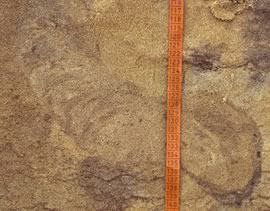

Identifying the animal
|Infill
Most studies of fossil burrows hinge on the condition that all of the burrows in a layer were filled during a single catastrophic event: a flood, or an ash-fall. This allowed Martin and Bennett (1977) to conclude that beavers of the genus Palaeocastor lived in colonies. They mapped an individual fossil town which contained 186 burrow casts.
If burrows are filled naturally, it cannot be expected that all fossil casts will stand out equally well. In fact, because they are often filled with the soil that sifts down from the surface, they will be unapparent.
In one fortunate case, just such unapparent burrow was recognized from the nuts that filled the storage chambers. Carole Gee and coworkers (2004), who studied this burrow, used computed x-ray tomography to examine the infill. The burrow appeared darker on the x-ray photograph, indicating a slight difference in density between the infill and the host rock.
A similar technique is used to examine rock cores from oil wells. Sandstones that appear massive to the naked eye turn out as distinctly laminated in x-rays (e.g. Miall 1990).